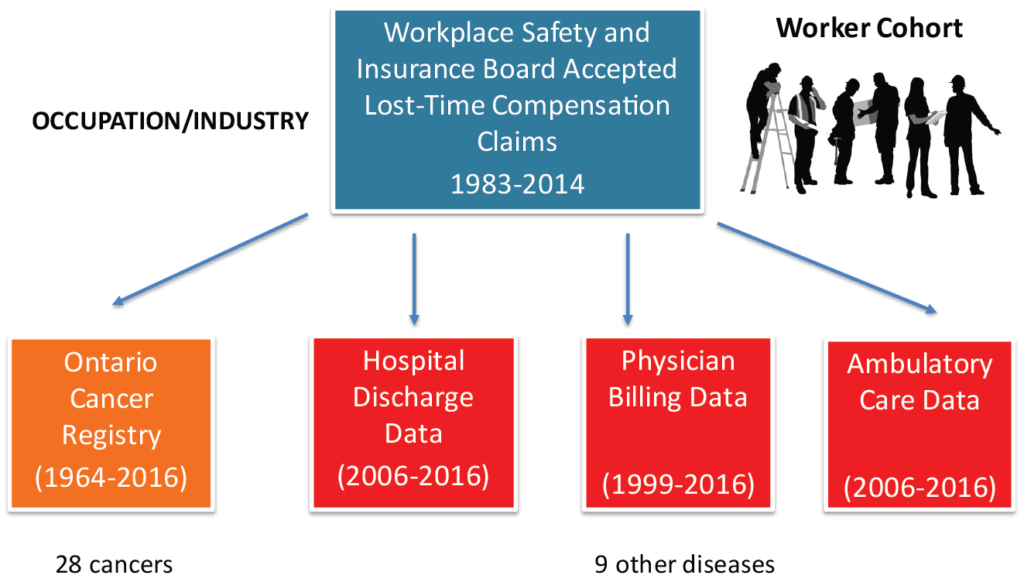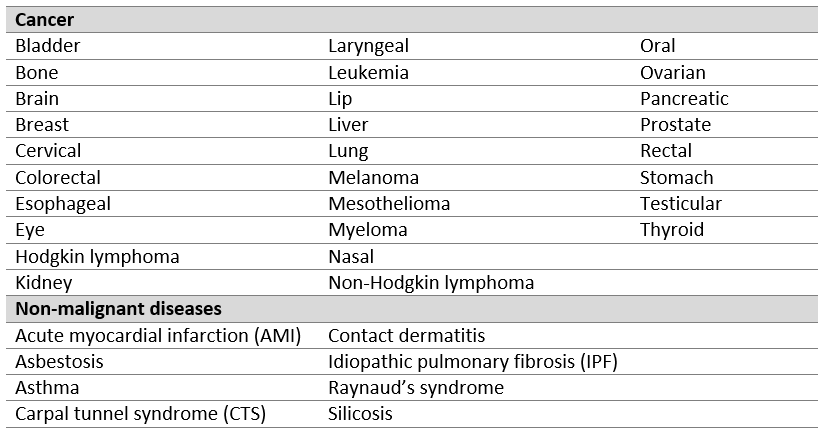Overview of the Occupational Disease Surveillance System (ODSS)
Why was the ODSS created?
Prior to the development of the ODSS, there were no occupational disease (including cancer) surveillance systems to identify high-risk populations and target prevention efforts in Ontario or other Canadian jurisdictions. Occupational diseases have generally been excluded from traditional workplace surveillance, which has focused primarily on injuries, and relied largely on workers’ compensation data. In addition, population-based risk factor surveillance systems, including the Public Health Agency of Canada’s Canadian Chronic Disease Surveillance System, do not capture information on where people work. Unfortunately, only a very small fraction of occupational chronic diseases are recognized or compensated, and work history is not part of routinely collected health data in Canada, so a new approach was needed.
How was the ODSS created?
The ODSS consists of 2.2 million Ontario workers with an accepted time loss compensation claim between 1983 and 2014. A worker who is compensated for a workplace-related illness or injury that resulted in missing work is captured in the provincial compensation board’s time-loss database. This database captures job information such as a worker’s occupation and industry of work associated with the claim. The ODSS was created by linking this source of job information to administrative health databases (see Figure).
Disease diagnoses are routinely collected in various databases when an individual interacts with the healthcare system, for instance when visiting a physician, hospital or cancer treatment centre. However, these databases do not typically contain any information about an individual’s job. While compensation claims do contain information on work, the majority of claims are for injuries, and occupational disease is often underreported and undercompensated.
To identify disease cases, this cohort of 2.2 million workers was linked to tumour registry data (Ontario Cancer Registry), hospital records (Canadian Institute for Health Information’s Discharge Abstract Database), ambulatory care records (National Ambulatory Care Reporting System), and physician billing records (Ontario Health Insurance Plan eClaims Database). By combining occupation and industry from time-loss compensation claims data with disease information from administrative health databases, the ODSS provides an efficient approach to study work-related diseases.

Which data sources are in the ODSS?
Workplace Safety and Insurance Board’s (WSIB) Time-Loss Claims Database
The WSIB time-loss claims database contains information related to accepted compensation claims for work-related injuries and illnesses. For each claim, records include the claim date, individual’s name, sex, birth date, death date (if applicable), the nature of injury or illness, company name and the occupation and industry at the time of claim. The WSIB codes workers’ jobs using two hierarchical coding systems for occupation and industry, which allows the ODSS to examine risk of disease at different levels of specificity. For instance, we can examine the risk of a particular disease in all construction occupations combined, or examine specific construction subgroups, such as painters, insulators or carpenters.
RPDB – Registered Persons Database
The Ontario Health Insurance Plan’s (OHIP) Registered Persons Database (RPDB) contains information about individuals who are registered for insured health services in Ontario through OHIP. Each registered person is assigned a unique 10-digit health insurance number (HIN). In order to link the WSIB time-loss records to other health administrative databases, WSIB records were first linked to the RPDB to retrieve the HIN, the common identifier between these data sources, required for subsequent linkages.
OCR – Ontario Cancer Registry
This database contains information about all newly diagnosed cancer cases in Ontario, excluding non-melanoma skin cancers. This database is used to identify cases of cancer in the ODSS.
Ontario Health Insurance Plan (OHIP) eClaims Database
This database contains records submitted by health care providers (primarily physicians) from independent health facilities, primary care, academic health science centres and hospitals for billing and accounting purposes. This database is used to identify cases of non-malignant disease in the ODSS.
NACRS – National Ambulatory Care Reporting System
This system contains data for ambulatory care visits including day surgery, outpatient and community-based clinics, and emergency departments. This database is used to identify cases of non-malignant disease in the ODSS.
DAD – Discharge Abstract Database
This database contains discharge information from inpatient hospitalizations. This database is used to identify cases of non-malignant disease in the ODSS.
Which diseases are studied in the ODSS?
The ODSS is currently being used to examine associations between occupation and industry and 28 cancer sites and 9 non-malignant health outcomes. Standard tumour registry case definitions are used for cancer. The case definitions for non-malignant diseases were developed with an advisory committee of occupational physicians and other experts, and include the age range during which a worker is considered at-risk, relevant diagnostic codes, the number of patient encounters required to be considered a case and the data sources (i.e. OCR, DAD, NACRS, OHIP) used to identify cases.
List of diseases studied in the ODSS

